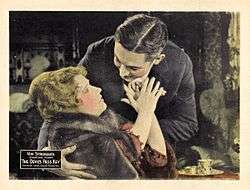The Devil's Pass Key
| The Devil's Pass Key | |
|---|---|
|
lobby card | |
| Directed by | Erich von Stroheim |
| Produced by | Carl Laemmle |
| Screenplay by | Erich von Stroheim |
| Story by |
Erich von Stroheim as "Baroness de Meyer" |
| Starring |
Sam de Grasse Mae Busch Maude George Leo White |
| Cinematography |
Ben F. Reynolds William H. Daniels Howard Oswald |
| Edited by |
Jean Spencer Grant Whytock |
Production company |
Jewel Productions |
| Distributed by | Universal Film Manufacturing Company |
Release dates |
|
Running time |
130 minutes (original cut) 80 minutes (original release) |
| Country | United States |
| Language | Silent (English intertitles) |
| Budget | $185,000 |
The Devil's Pass Key (or The Devil's Passkey) was a 1920 silent drama film directed by Erich von Stroheim.[1][2][3][4]
The film was produced by Universal Pictures and distributed under their Jewel banner.[3] The film was von Stroheim's second directorial effort,[5] and considered one of the best screen exhibitions of August 1920,[6][7] with The New York Times later calling it "One of the best photodramatic productions of the year".[8] The production was shot from September 1919 through December 1919 and premiered on 8 August 1920 at the Capitol Theatre in New York City, New York.
Plot
As described in a film magazine,[9] Grace Goodright (Trevelyn) is the beautiful but extravagant wife of Warren Goodright (de Grasse), an American playwright living in Paris. Grace is living beyond her means and owes her modeste Renee Malot (George) money. Malot suggests that Grace contact a wealthy American, army officer Captain Rex Strong (Clyde Fillmore), who might be able to assist her financially. Rex offers Grace a loan, but only if as "security" for the loan she grants him sexual favors. Grace refuses, and Malot, angered at losing an opportunity for obtaining a commission for the loan, attempts to trap Grace in a blackmail scheme. The newspapers print the spicy bit of scandal without mentioning any names. Warren uses the story as the plot for his next play and it meets success. Paris is thrown into a furor over the affair and Warren threatens the life of Captain Strong. After the later convinces Warren that his wife is innocent, the matter is resolved happily.
Cast
- Sam de Grasse as Warren Goodright
- Mae Busch as La Belle Odera
- Maude George as Renee Malot
- Leo White as Amadeus Malot
- Jack Mathis as Count De Trouvere
- Albert Edmondson as Alphonse Marior
- Una Trevelyn as Grace Goodright
- Clyde Fillmore as Captain Rex Strong
- Ruth King as Yvonne Strong
- Edward Reinach as Director of Theatre Français
Preservation status
In 1941, it was discovered that the original nitrate negative had decomposed in the Universal film vaults, and the film is today famous as a lost film. A story in The Hollywood Reporter, international edition, dated 12 November 1993, stated that this film would be shown at the 1994 Berlin Film Festival — a film previously thought to be lost. As of July 2015, the validity of this has not yet been proven.[4][10] Because this film has been lost for so long, historians often omit it when discussing or writing about the canon of von Stroheim's film work.
_-_5.jpg)
See also
References
<div class="reflist columns references-column-width" style="-moz-column-width: [1]
[8]; -webkit-column-width: [1]
[8]; list-style-type: decimal;">
- 1 2 3 4 "The Screen: The Devil's Pass Key". The New York Times. The New York Times archives. August 9, 1920. Retrieved 27 November 2010.
- 1 2 3 4 "Noticed and Noted". The New York Times. September 5, 1920. Retrieved 27 November 2010.
- 1 2 3 4 5 Koszarski, Richard (1983). The Man You Loved to Hate: Erich von Stroheim and Hollywood. Oxford University Press. p. 46. ISBN 0-19-503239-X.
- 1 2 3 4 5 Lennig, Arthur (2003). Stroheim (2, illustrated ed.). University Press of Kentucky. ISBN 0813190444.
- 1 2 3 4 Georges Sadoul, Peter Morris (1972). Peter Morris, ed. Dictionary of Film Makers. University of California Press. p. 224. ISBN 0520021517.
- 1 2 3 4 Slide, Anthony (1982). Anthony Slide, ed. Selected Film Criticism: 1912-1920. G - Reference, Information and Interdisciplinary Subjects Series (revised, illustrated ed.). Scarecrow Press. pp. 71, 72. ISBN 0810815257.
- 1 2 3 4 Koszarski, Richard (1977). The Unknown Cinema of Erich von Stroheim: Reconstruction and Analysis of The Devil's Pass Key, Queen Kelly and Walking Down Broadway. New York University. pp. 93 through 105.
- 1 2 3 4 "Screen: People and Plays". The New York Times. January 2, 1921. Retrieved 27 November 2010.
- ↑ "Reviews: The Devil's Pass Key". Exhibitors Herald. New York City: Exhibitors Herald Company. 10 (24): 74. June 12, 1920.
- ↑ Progressive Silent Film List: The Devil's Pass Key at silentera.com
External links
| Wikimedia Commons has media related to The Devil's Pass Key. |
- The Devil's Pass Key at the Internet Movie Database
- The Devil's Pass Key at the TCM Movie Database
- The Devil's Pass Key at American Movie Classics
- Lantern slide plate for the film
